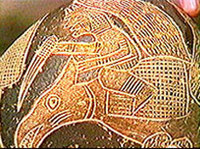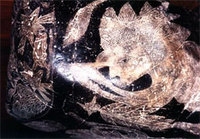But what if there were already better evidence that at least some dinosaurs had survived long enough to coexist with humans? Evidence better than just stories. What if early humans had actually etched pictures of dinosaurs on rock faces. That would constitute pretty good proof, wouldn't it?
Such rocks exist.
Known collectively as the Ica Stones (they are found in Ica, Peru), these rocks, varying in size from that of a baseball to twice that of a basketball, are hand-etched with pictures of primitive fish, dinosaurs and Indians using what appear to be tools of advanced technology. The problem is, the age of these rocks cannot be verified. But they are intriguing, and they have delighted tourists and mystified researchers for decades.

|
| ©Dan Eden, Viewzone |
| This etching on one of the stones seems to show a man riding a pterodactyl. |
Where Did They Come From?
The Ica Stones first came to the attention of the scientific community in 1966 when Dr. Javier Cabrera, a local physician, received a small, carved rock for his birthday from a poor native. The carving on the rock looked ancient to Dr. Cabrera, but intrigued him because it seemed to depict a primitive fish. Hearing that the doctor was interested in the stone, local natives began to bring him more, which they collected from a river bank (not far from the famous Nazca lines). This soon developed into a vast collection of more than 15,000 stones, many etched with impossible scenes. Whereas it might be difficult to prove that the fish represented a long-extinct species, as Dr. Cabrera thought, other scenes carved on other stones are not so ambiguous. They clearly depict such dinosaurs as triceratops, stegosaurus, apatosaurus and human figures riding on the backs of flying pterodactyls. What's more, some of the scenes are of men hunting and killing dinosaurs. Others show men watching the heavens through what look like telescopes, performing open-heart surgery and cesarean section births.
How could this be? Modern man is only about 2 million years old and dinosaurs are thought to have become extinct about 60 million years ago. There are three possibilities:
-a human civilization existed during the age of the dinosaurs
-dinosaurs survived to coexist with man
-the stones are an elaborate hoax.
The stones themselves are composed of andesite, a very hard mineral that would make etching quite difficult with primitive tools. They are covered with a natural varnish that is created by bacteria over thousands of years. The etching is made by scraping away this dark varnish to reveal the lighter mineral beneath. According to some reports, examinations of the stones show that the grooves of the etchings also bear traces of additional varnish, however, indicating that they are very old.
Ica natives had been selling such stones to the tourist trade. In fact, when one man was arrested for selling them (if the stones are genuine artifacts, they would be the property of the government and therefore illegal to sell), he confessed to carving the images himself. Those who believe the carvings are authentic suspect that the confession was made to avoid jail. Yet natives of the area can be seen today making etchings on stones in the style of the Ica Stones to sell to tourists. But the distinction between their product and the "genuine" stones is that the newly etched stones clearly scrape away all of the varnish.
Dating the Stones
Unfortunately, it's impossible to date the Ica Stones themselves. Radiocarbon dating can only be used on artifacts that contain organic material, which the stones do not. Rocks can only be dated by examining the strata in which they are found, but since the Ica Stones were uncovered by the erosion of a river bank (or in an unidentified cave, depending on which story you believe), the strata of their original resting place is unknown.

|
| ©Dan Eden, Viewzone |
| This stone depicts a dinosaur of some kind - an animal ancient man should not have seen. |
The implications of these stones are incredible. Perhaps too incredible. If they are authentic, they change everything we know about the history of human life on Earth.
Authentic or Hoax?
Let's again look at the three possibilities:
-An advanced human civilization existed at the time of the dinosaurs. This is the theory favored by Dr. Cabrera. He believes the stones are the record left by an advanced civilization. He contends that the stones constitute a library of this civilization's knowledge of medicine, astronomy, prehistoric animals and aeronautics, and that they fled (as the stones indicate) to another planet in the advent of some natural catastrophe. Does this make sense? Why would a people advanced enough to build telescopes, perform complicated surgery and capable of interstellar travel leave records crudely etched on rocks? Why are they depicted hunting dinosaurs with primitive weapons? There is no other evidence of this advanced civilization.
-Dinosaurs survived to coexist with humans. This is theoretically possible, but there is no fossil record of triceratops, stegosaurus or any other dinosaur being alive in the same era as humans. Some fundamentalist Christians, who contend that the Earth is only a few thousand years old, believe that there is fossil evidence of dinosaur and human footprints found together in such places as the Paluxy riverbed. These conclusions are, of course, hotly contested by scientists.
-They are a hoax. This seems to be the most likely and logical conclusion. Yet anyone with an interest in these curiosities would welcome a thorough, rigorous scientific investigation and examination of the stones, rather than dismissing them out of hand simply because their implications are too fantastic. A scientific study would put the matter to rest.
The Julesrod Collection
The Ica Stones aren't the only controversial artifacts that seem to depict dinosaurs. About 50 years ago, an amateur archeologist named Val Julesrod began collecting clay figurines that had been unearthed in Mexico, and have been radiocarbon dated to be about 3,500 years old. While most of the figurines (there are more than 30,000 of them) are stylized human heads, some are of animals that strongly resemble camels, elephants and horses - animals that did not exist in Mexico 3,500 years ago. Others dated at 1,500 years old are monstrous forms that could be interpreted as dinosaurs. Or are they just mythical creatures?



Reader Comments
to our Newsletter